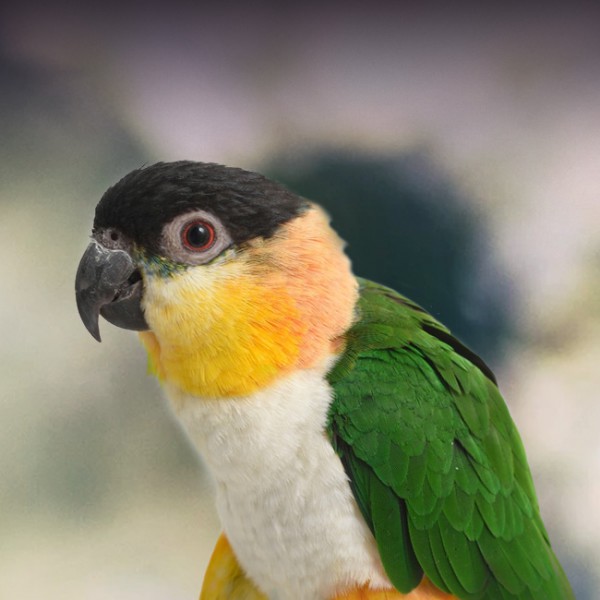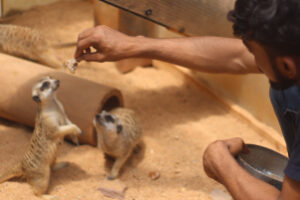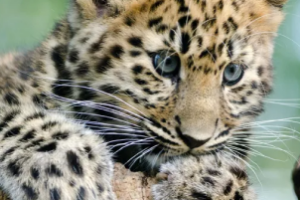
WORLD OF ANIMALS : CAIQUE
BY JANANI ARUN :-
The Caiques are species of parrots in the genus Pionites. They are small high-energy, mischief maker with a short square tail, very bright colors and they’re known to be the clowns of the bird world. Caiques is very playful and affectionate. These are small parrots about 9 to 10 inches long and can adapt well to captivity and adjust easily to their environment. They have delightful and comical personalities and will readily learn tricks. Though not good talkers they can mimic sounds in their environment. The handfed caique makes a loving pet that immediately becomes a member of the family.
There are two species in the Caiques: the White-bellied Caique, and the Black-headed Caique. Within these two species, there are five sub-species, two Black-headed and three White-bellied. White-bellied Caique – Green-thigh, White-bellied Caique – Yellow-thigh, White-bellied Caique – Yellow-tail. Black-headed and Black-headed Caique – Pallid. Caique can live up to 25 to 40 years.
Habitat
Caique’s are native to South America. White-bellied Caiques live in terrestrial lowland tropical rainforests and Terra firme forests. However, they are more found in varea forests. These forests are prone to flooding and have high humidity, which provide ideal habitat for white-bellied Caiques. They are more commonly found in trees watercourses. The Black-headed Caique also found in South America: north of the Amazon, from the Guianas westward to Colombia, Venezuela, and Peru. They inhabit the tree of tropical and savannah forests.
Personality
In captivity, Caiques are known as the clowns of the parrot community. They exhibit playful behaviors such as hopping or frequently lying on their backs. They are known for the strong bonds that they can form with humans. They love attention, can be quite affectionate and enjoy time playing with a human companion. Quick learners with a great personalities. Always on the move, they’re one of the most energetic and mischievous parrots. Their groups in the forest, spending most of the day feeding and resting. They participate in preening (tidy and clean its feathers) behaviors and are generally sociable during resting time.
Diet
In the wild, Caiques eat seeds, berries, and fruit. In Captivity carrots, pumpkins, Leafy green vegetables like Chard, kale, or collard greens broccoli, zucchini, beets, cooked sweet potato are nutritious to their diet. Fruits like apples, pears, oranges, Musk melon or honeydew melon, peaches, plums, papaya, mangos, berries, cherries kiwi, and Star fruit. Seeds like quinoa (kinwa), amaranth (Chaulai), barley, or buckwheat (kuttu). Walnuts, pumpkin seeds, flax seeds, almonds as the nuts have high-fat content, they must be served in very little quantities. Before serving the seed mix, make sure to cook, soak, or sprout them to make it chewable for the Caique. Seeds form an important part of a bird’s diet. But they must be served in small quantities only. As they not only lack vitamins, minerals, and nutrients, but they have added fat that can cause obesity. To make it worse, the packaged seed-mix contains preservatives and sulfur that are harmful to the Caique’s health. Cuttlebone, grit and a mineral block should be given to Caiques to avoid egg binding and calcium deficiencies. For optimal calcium metabolism, Caique will need some UVB (Sun light) exposure for at least 3-4 hours a day.
Few foods must never be served, that contain caffeine like chocolates are toxic to the bird. Alcohol or carbonated drinks must not be fed. All the pitted fruits like avocado, foods rich in oxalic acid like rhubarb, foods with sulfur content like onion, or foods rich in amatoxin like mushrooms, are all harmful to the bird.
Health and Common Conditions
Caique species is may likely get polyomavirus, a deadly infection mostly in young birds that causes severe intestinal issues and can affect heart, liver, and kidneys of a bird. The symptoms are feather loss, lethargy, diarrhea and loss of appetite, tremor, bruising, reddened skin, small sores and swollen belly. Some of the common illnesses in Caique could be internal parasites, intestinal influenza, coccidiosis, respiratory ailments, feather picking, and parrot fever also known as psittacosis.
Housing
Their bird cage should provide room for lots of movement as well as space for perches, food dishes and a variety of playthings. A minimum of 24″ wide by 24″ high by 24″ length (60 x 605 x 60 cm) is okay for a Caique, though the bigger the cage the better for them to play. A chew resistant metal bird cage is important, as a wooden cage will easily be destroyed. Horizontal bars on the sides are nice as they love to climb. Provide two perches, place one bird perch up high for roosting and one low by the food and water dishes. Caique’s love to chew and will gnaw on the perches. Natural perches from willow, poplar and fruit trees are good for the bird’s feet. An outdoor aviary needs to have a protected shelter that can be necessary. The flight should long with a perch at each end. A climbing branch and a bird bath would be nice.
Breeding
Caiques gender may be quite tricky, the only way to determine the sex of a Caique is by DNA and surgical testing. Caiques are extremely productive and willing breeders. The Caique normally reaches sexual maturity at about 4 years depending on the individual. They are seasonal breeders beginning their season in early spring and late summer. Caiques will lay a clutch of three to four eggs. Eggs are usually laid at two-day intervals. Incubation usually begins after the third egg is laid and lasts for 25 days. Chicks that raised by the parents Fledge at about ten weeks of age although they will still be fed by their parents and continue to sleep in the nest box. Weaning is usually completed by 13-14 weeks of age. It is very apparent when Caiques are about to lay eggs. Their lower abdomens swell-up. They will usually swell-up a week or so before egg-laying.
Vocalizations
Caiques may learn to speak a few words, but most prefer to speak bird. You’ll enjoy their whistles and songs as well as the environmental sounds they mimic. At times, they may emit calls that are very high-pitched and shrill.
Training Caique Parrot
An untrained Caique can ultimately bring trouble oneself. Aggressive, cranky, and territorial are all negative behaviors and can be a cause of unhappiness. So training the bird from day one is important. To correct Caiques bad behavior while the bird is at it, make him step-up on the finger and bring him to the eye level. Talk to your caique gently by keeping the voice and tone soft. Emote the displeasure with facial expressions of his/her behavior. Then, put the bird back in his cage and leave for few minutes. Make sure to return back in some time to play, and to let the bird know he/she is not been abandoned.
Caique’s and Activities
If there’s one thing Caiques love to do is to play. For their size, Caiques play harder, longer and more roughly. Playing is not only good for them physically; it is also an essential part of their mental stimulation. Caiques especially enjoy climbing and chewing. Provide your Caiques with lots of bird activities in the form of large link chains, bird ladders, parrot swings, ropes, parrot toys, and fresh branches for gnawing and chewing. Caiques really enjoy lying on their backs when they play, so small toys which can be held in their feet are big favorite. Toys for Caiques (and most other birds) should contain a variety of textures, consistencies, colors, sizes and shapes. Caiques are very mentally active birds, and enjoy variety in their toys.
Interesting Facts
- Caique are deaf at birth, and can only start hearing after 3-weeks.
- At times, they sneak into wet leaves and rub themselves.




